Preludes, Op. 23 (Rachmaninoff)

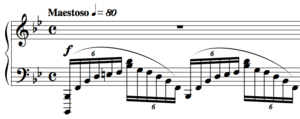
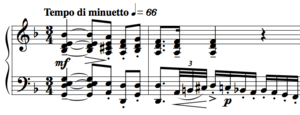
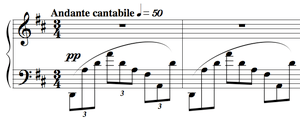

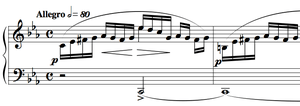
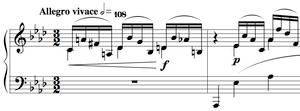

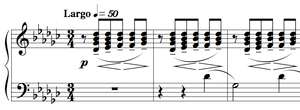
Ten Preludes, Op. 23, is a set of ten preludes for solo piano, composed by Sergei Rachmaninoff in 1901 and 1903. This set includes the famous Prelude in G minor.
Together with the Prelude in C-sharp minor, Op. 3/2 and the 13 Preludes, Op. 32, this set is part of a full suite of 24 preludes in all the major and minor keys.
Composition
Op. 23 is composed of ten preludes, ranging from two to five minutes in length. Combined, the pieces take around thirty minutes to perform. They are:
- No. 1 in F-sharp minor (Largo)
- No. 2 in B-flat major (Maestoso)
- No. 3 in D minor (Tempo di minuetto)
- No. 4 in D major (Andante cantabile)
- No. 5 in G minor (Alla marcia)
- No. 6 in E-flat major (Andante)
- No. 7 in C minor (Allegro)
- No. 8 in A-flat major (Allegro vivace)
- No. 9 in E-flat minor (Presto)
- No. 10 in G-flat major (Largo)
Rachmaninoff completed Prelude No. 5 in 1901. The remaining preludes were completed after Rachmaninoff's marriage to his cousin Natalia Satina: Nos. 1, 4, and 10 premiered in Moscow on February 10, 1903, and the remaining seven were completed soon thereafter.[1] 1900-1903 were difficult years for Rachmaninoff and his motivation for writing the Preludes was predominantly financial.[2] Rachmaninoff composed the works in the Hotel America, financially dependent on his cousin Alexander Siloti, to whom the Preludes are dedicated.
Analysis
Rachmaninoff's Ten Preludes abandon the traditional short prelude form delineated by composers such as Bach, Scriabin, and Chopin. Unlike Chopin's, some half-page musical fragments, Rachmaninoff's Ten Preludes last for several minutes each, expanding into complex polyphonic forms with musically independent sections.[2] The pieces perhaps represent a culmination of the Romantic idiom.[3] The set reflects Rachmaninoff's experience as a virtuoso pianist and master composer, testing the "...technical, tonal, harmonic, rhythmic, lyrical, and percussive capabilities of the piano."[3]
The popular Prelude in C-sharp minor, Op. 3, No. 2 perhaps unfairly eclipses the Op. 23 Preludes. Rachmaninoff remarked, "...I think the Preludes of Op. 23 are far better music than my first Prelude, but the public has shown no disposition to share in my belief...." [4] The composer never played all of the Preludes in one sitting, preferring to cycle through a rotating mix of his favorites.[5] Nonetheless, certain characteristics of the work, such as the recurrence of stepwise motion, common chords between adjacent preludes, and the bookended relationship between the first and last preludes (both marked Largo, with the latter in the parallel major of the former) suggest that the works could be played as a set. Together with Op. 32 and Op. 3, Rachmaninoff's Preludes represent all twenty-four major and minor keys.[6]
From a performance standpoint, the ten Op. 23 Preludes exhibit wide variations in difficulty. Nos. 1, 4, 5, and 10 are conceivably in reach of the "advanced-intermediate" pianist, while the endurance and dexterity demanded by nos. 2, 3, 6, 7, 8, and ‒ above all ‒ 9, require more advanced skill.[3] Nonetheless, even the "easier" preludes present subtle interpretive challenges in counterpoint, dynamic control, and timing, putting true mastery of the pieces out of reach to all but those with virtuosic skill.[3]
Reception and criticism
The Ten Preludes, along with the Op. 3 prelude and the Thirteen Preludes of Op. 32, are considered to be among Rachmaninoff's best works for solo piano.[3] The "Russian" quality of the Op. 23 preludes is often noted by listeners: after hearing Boris Asafyev play the preludes, the painter Ilya Repin noted a streak of Russian nationalism and originality in rhythm and melody. At the same recital, Vladimir Stasov praised the characteristic "Rachmaninoff sound" and unusual and innovative bell-like quality of the pieces, and Maxim Gorky simply noted, "How well he hears the silence."[3]
Music editions
Most editions of the Op. 23 Preludes contain significant editorial distortions in dynamics and phrasing. In 1986, Ruth Laredo set out to produce the first authentic version, but was unable to obtain the original manuscripts. The Piano Quarterly praised Laredo's editorial practices, remarking that, "this seems to be the edition to own."
However, in 1992, Boosey & Hawkes published an edition edited by Robert Threlfall, who had managed to obtain access to the original manuscripts. This edition is widely regarded as the first truly authentic version.[7]
See also
References
- ↑ Norris, Geoffrey, Rachmaninoff, pg. 170 Schirmer Books (1993).
- 1 2 Lamagra, Anthony J., A Source Book for the Suty of Rachmaninoff's 'Preludes', Ed.D. dissertation, Columbia University (Publication No. AAT 6702817).
- 1 2 3 4 5 6 Lamagra, Anthony J., A Source Book for the Suty of Rachmaninoff's 'Preludes', Ed.D. dissertation, Columbia University (Publication No. AAT 6702817), p.232.
- ↑ Sergi Bertensson and Jay Leyda, Sergei Rachmaninoff: A Lifetime in Music, NYU Press, p.162 (1956).
- ↑ Martyn, Barrie, Rachmaninoff: Composer, Pianist, Conductor', Scholar Press (1990).'
- ↑ Martyn, Barrie, Rachmaninoff: Composer, Pianist, Conductor', p. 148, Scholar Press (1990).'
- ↑ Cunningham, Robert, Jr., Sergei Rachmaninoff: A Bio-Bibliography, Greenwood Press (2001).
External links
- Preludes, Op. 23: Scores at the International Music Score Library Project (IMSLP)
- (in Russian) Piano.ru - Sheet music download
- (in Russian) Chubrik.ru - Audio download
- Prelude in C Minor Op. 23 no. 7 – Live by Chen Ben David (2016) on YouTube
- Prelude in G minor Op. 23 no. 5 – Live by Emil Gilels (1978) on YouTube
- Prelude in B-flat Major Op. 23 no. 2 – Live by Svytoslaw Richter on YouTube